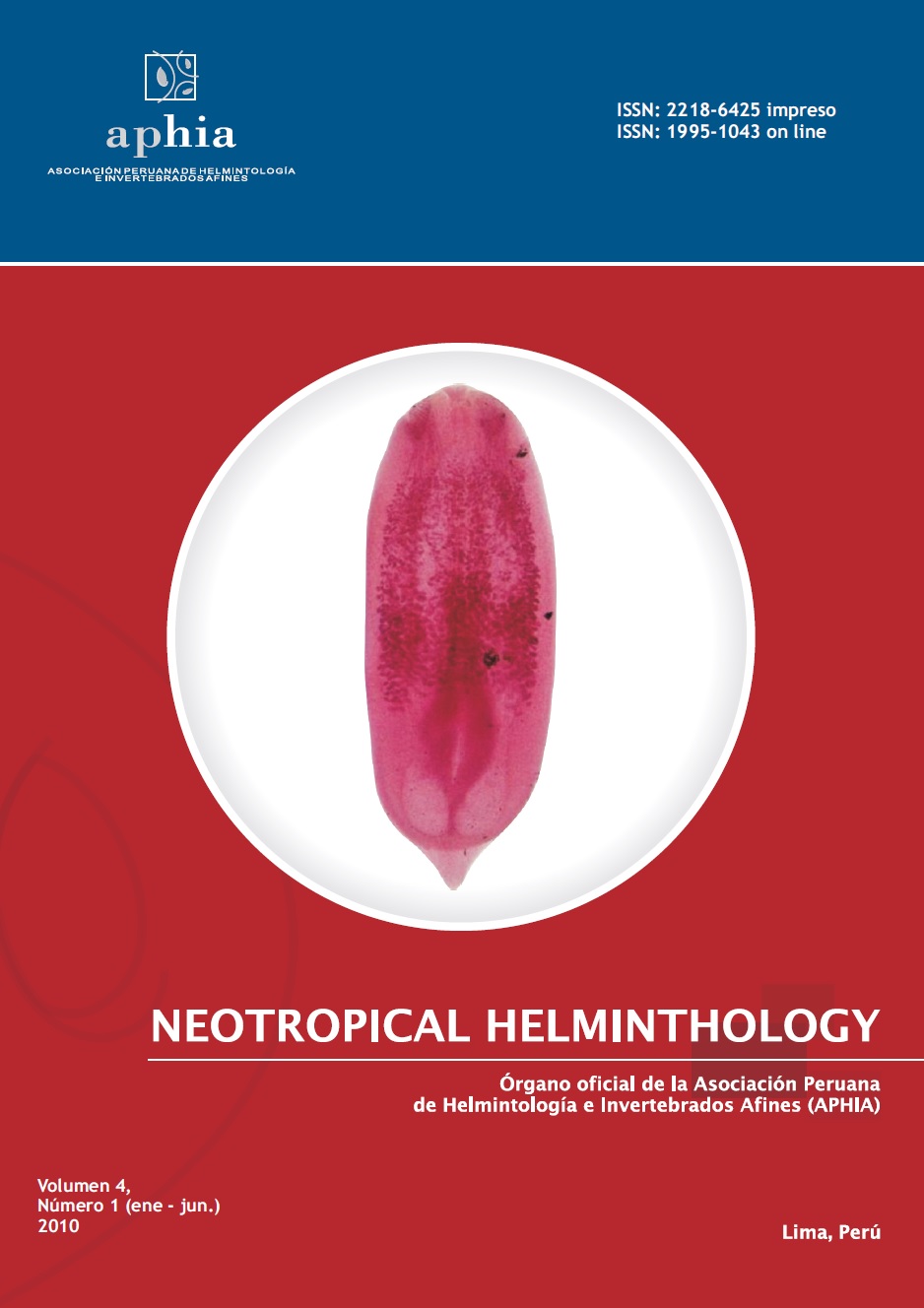INTESTINAL PARASITISM, RISK FACTORS AND SEROPREVALENCE OF TOXOCARIOSIS IN INHABITANTS OF THE INDUSTRIAL PARK OF HUAYCAN, LIMA, PERU
DOI:
https://doi.org/10.24039/rnh2010411089Keywords:
Blastocystis, Enteroparasitism, factor of risk, prevalence, ToxocariosisAbstract
From December 2007 to June 2008, a parasitological research among the population of Parque Industrial Huaycán, in Ate Vitarte district, province of Lima, Peru was performed, in order to determine the prevalence of intestinal parasites and risk factors as well as to determine the sero-prevalence of human Toxocariosis. The coprological samples were analized by the Direct Method with lugol, rapid Sediment in Lumbrera`s glass, and Kinyoun dye for coccidia; and ELISA technique for sero-diagnose of human Toxocariosis. For soil samples, glass sediment and the Baermann-Lumbrera`s technique were used. The Graham method was used for the diagnosis of enterobiosis. Prevalence of enteroparasitism was 74.24%. The most prevalent species of pathogenic protozoa were: Blastocystis hominis Brumpt, 1912 (52.51%) and Giardia lamblia (Lamb, 1859) (18.16%); and among helminths, Enterobius vermicularis Limaeus, 1758 (9.50%). The risk factors which favor the persistence of intestinal parasites were: to poor environmental sanitation, as houses with soilfloor which lack drinking water and sewers, and throw their waste on a heap of rubbish. Also, bad hygiene habits, as playing with soil, or not washing their hands before eating, or after using the toilet. Another factor of risk is having animals at home, especially dogs. The sero-prevalence of human Toxocariosis in the studied population was of 30.23%, where as 23.26% of the population were marked as suspectful for the disease. The factors of risk related to with the human Toxocariosis were: dogs kept in the house and houses with soil floor.
Downloads
Published
How to Cite
Issue
Section
License

This work is licensed under a Creative Commons Attribution-NonCommercial-NoDerivatives 4.0 International License.
OBJETO: El AUTOR-CEDENTE transfiere de manera TOTAL Y SIN LIMITACIÓN alguna al CESIONARIO los derechos patrimoniales que le corresponden sobre la (s) obra(s) tituladas: xxxxxxxxxxxxxxxx, por el tiempo que establezca la ley internacional. En virtud de lo anterior, se entiende que el CESIONARIO adquiere el derecho de reproducción en todas sus modalidades, incluso para inclusión audiovisual; el derecho de transformación o adaptación, comunicación pública, traducción, distribución y, en general, cualquier tipo de explotación que de las obras se pueda realizar por cualquier medio conocido o por conocer en el territorio nacional o internacional.
REMUNERACIÓN: La cesión de los derechos patrimoniales de autor que mediante este contrato se hace será a título gratuito.
CONDICIONES Y LEGITIMIDAD DE LOS DERECHOS: El AUTOR-CEDENTE garantiza que es propietario integral de los derechos de explotación de la(s) obra(s) y en consecuencia garantiza que puede contratar y transferir los derechos aquí cedidos sin ningún tipo de limitación por no tener ningún tipo de gravamen, limitación o disposición. En todo caso, responderá por cualquier reclamo que en materia de derecho de autor se pueda presentar, exonerando de cualquier responsabilidad al CESIONARIO.
LICENCIA DE ACCESO ABIERTO: El AUTOR-CEDENTE autoriza que manuscrito publicado en La Revista Neotropical Helminthology permanece disponible para su consulta pública en el sitio web https://www.neotropicalhelminthology.com/ y en los diferentes sistemas de indexación y bases de datos en las que la revista tiene visibilidad, bajo la licencia Creative Commons, en la modalidad Reconocimiento-No comercial- Sin Trabajos derivados –aprobada en Perú, y por lo tanto son de acceso abierto. De ahí que los autores dan, sin derecho a retribución económica, a la Asociación Peruana de Helmintología e Invertebrados Afines (APHIA), los derechos de autor para la edición y reproducción a través de diferentes medios de difusión.


 Numero 2 Volumen 19 - 2025 (versión Anticipada)
Numero 2 Volumen 19 - 2025 (versión Anticipada)














































